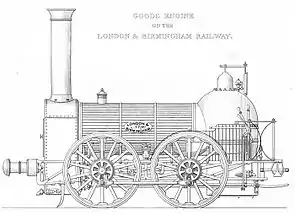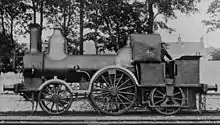Bury Bar Frame locomotive
The Bury Bar Frame locomotive was an early type of steam locomotive, developed at the works of Edward Bury and Company, later named Bury, Curtis, and Kennedy. By the 1830s, the railway locomotive had evolved into three basic types - those developed by Robert Stephenson, Timothy Hackworth and Edward Bury.
.jpg.webp)

Frames
A major problem was the effect of their weight on the track of the time. Engines were increasing in size as more power was needed. Robert Stephenson had developed the Patentee with an extra pair of wheels to distribute the weight. However, this brought problems in that the extra length affected road-holding on curves. Such locomotives used a heavy, rigid frame of timber sandwiched between iron plates outside the wheels, plus internal iron sub-frames. Bury adopted a different approach by keeping to two axles and fabricating a bar frame inside the wheels, consisting (on each side) of two wrought-iron bars, a rectangular-section bar above the axle bearings and a round-section bar below.
From 1845 Bury built much bigger six-wheeled locomotives with bar frames; one of these, a 2-2-2 of 1847, was preserved and may be seen in Cork railway station.
Boilers
Bury engines were also notable for their round topped "haystack" fireboxes from 1830 until mid-1847; thereafter Bury, Curtis & Kennedy's engines were fitted with a raised but straight-topped firebox. The boiler pressure was gradually increased from 50 psi in the 1830s to a maximum of 85 psi by about 1850.
Advantages and disadvantages

While Bury's four-wheeled engines were criticised for their alleged lack of strength and power they were fast and held the road well. The design was emulated by a number of manufacturers and they lasted on the London & North Western Railway until the 1860s, and on other lines until much later. The main problem with them (and with other inside-cylinder engines) was the breakage of the crank axle but this was a rare occurrence with Bury's engines.
Use in the United States
In America, where there were immense distances laid with often indifferent track, they were in use until the twentieth century. In addition, their large fireboxes made them particularly suitable for wood burning. The bar-frame was adopted in the U.S. as standard for subsequent locally built locomotives.
Use in the UK
In England, distances were shorter and traffic density was rising, so the trackwork was gradually improving. During the 1840s Stephenson had increased the power in his long boiler locomotive, while in 1847, David Joy introduced the Jenny Lind design.
References
| Wikimedia Commons has media related to Bury bar-frame locomotives. |
- Lowe, J.W. (1989). British Steam Locomotive Builders. Guild Publishing.
- Williams, R. (1988). The Midland Railway: A New History. Newton Abbot: David and Charles.
- Jack, Harry (2001). Locomotives of the LNWR Southern Division. RCTS.